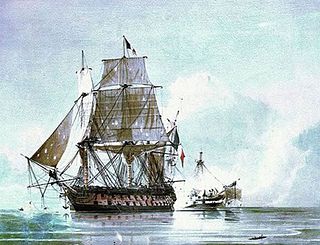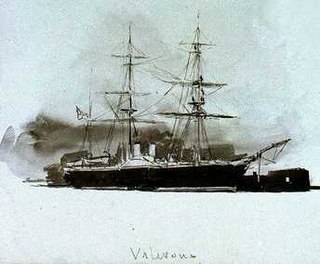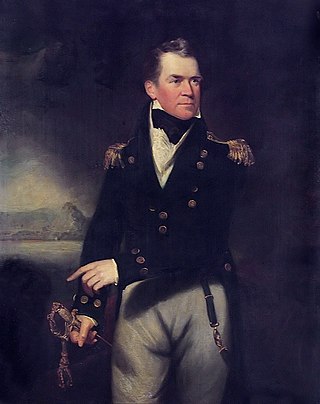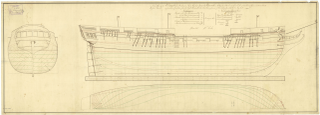
USS Constitution, also known as Old Ironsides, is a three-masted wooden-hulled heavy frigate of the United States Navy. She is the world's oldest commissioned naval warship still afloat. She was launched in 1797, one of six original frigates authorized for construction by the Naval Act of 1794 and the third constructed. The name "Constitution" was among ten names submitted to President George Washington by Secretary of War Timothy Pickering in March of 1795 for the frigates that were to be constructed. Joshua Humphreys designed the frigates to be the young Navy's capital ships, and so Constitution and her sister ships were larger and more heavily armed and built than standard frigates of the period. She was built at Edmund Hartt's shipyard in the North End of Boston, Massachusetts. Her first duties were to provide protection for American merchant shipping during the Quasi-War with France and to defeat the Barbary pirates in the First Barbary War.

In 1603 all English warships with a complement of fewer than 160 men were known as 'small ships'. In 1625/26 to establish pay rates for officers, a six-tier naval ship rating system was introduced. These small ships were divided into three tiers: fourth-, fifth- and sixth-rates. Up to the end of the 17th century, the number of guns and the complement size were adjusted until the rating system was actually clarified. A 'fourth-rate' was nominally a ship of over thirty guns with a complement of 140 men.

HMS Leander was a Portland-class 50-gun fourth rate of the Royal Navy, launched at Chatham on 1 July 1780. She served on the West Coast of Africa, West Indies, and the Halifax station. During the French Revolutionary Wars she participated in the Battle of the Nile before a French ship captured her. The Russians and Turks recaptured her and returned her to the Royal Navy in 1799. On 23 February 1805, while on the Halifax station, Leander captured the French frigate Ville de Milan and recaptured her prize, HMS Cleopatra. On 25 April 1805, cannon fire from Leander killed an American seaman while Leander was trying to search an American vessel off the US coast for contraband. The resulting "Leander affair" contributed to the worsening of relations between the United States and Great Britain. In 1813, the Admiralty converted Leander to a hospital ship under the name Hygeia. Hygeia was sold in 1817.

The capture of HMS Cyane and HMS Levant was an action which took place at the end of the Anglo-US portion of the War of 1812. The two British warships HMS Cyane and HMS Levant fought USS Constitution on 20 February 1815, about 100 miles east of Madeira. Following exchanges of broadsides and musket fire, both Cyane and Levant surrendered. The war had actually finished a few days before the action with the ratification of the Treaty of Ghent by both sides, but the combatants were not aware of this.
HMS Prince Regent was a 56-gun British warship that served on Lake Ontario during the War of 1812. Prince Regent was built at the Kingston Royal Naval Dockyard in Kingston, Upper Canada and launched on 14 April 1814. Rated as a fourth-rate frigate, Prince Regent took part in the Raid on Fort Oswego in 1814. Following the War of 1812 the frigate was renamed HMS Kingston on 9 December 1814. In 1817, the vessel was placed in reserve following the Rush-Bagot Treaty that demilitarized all the lakes along the United States-Canada border. Discarded in 1832, the vessel found no buyer and sank in Deadman Bay off Kingston after 1832.

HMS Warspite was a 74-gun third-rate ship of the line of the Royal Navy, launched in 1807. She served in the Napoleonic Wars and was decommissioned in 1815. After conversion to a 76-gun ship in 1817 she circumnavigated the world, visiting Australia. She was cut down to a single decker 50-gun frigate in 1840 and was decommissioned in 1846. She was lent as a boys' training ship to The Marine Society and was lost to fire in 1876.

HMS Valorous was one of two 16-gun, steam-powered Magicienne-class second-class paddle frigates built for the Royal Navy in the 1850s. Commissioned in 1853 she played a small role in the Crimean War of 1854–1855 and was sold for scrap in 1891.

HMS Cyane was a Royal Navy Banterer-class sixth-rate post ship of nominally 22 guns, built in 1806 at Topsham, near Exeter, England. She was ordered in January 1805 as HMS Columbine but renamed Cyane on 6 December of that year. Cyane had a distinguished career in British service that included the award in 1847 of a clasp to the Naval General Service Medal to any still surviving crew members of either of two actions. On 20 February 1815, she and HMS Levant engaged USS Constitution; outgunned, both had to surrender. She then served as USS Cyane, including a stint on anti-slavery duties, until she was broken up in 1836.

HMS President was a large frigate in the British Royal Navy (RN). She was built to replace the previous HMS President, redesignated from the heavy frigate USS President built in 1800 as the last of the original six frigates of the United States Navy under the Naval Act of 1794. The first President had been the active flagship of the U.S. Navy until captured while trying to escape the Royal Navy blockade around New York in 1815 at the end of the War of 1812, and then served in the RN until broken up in 1818. The new British President was built using her American predecessor's exact lines for reference, as a reminder to the United States of the capture of their flagship – a fact driven home by President being assigned as the flagship of the North America and West Indies Station in the western Atlantic Ocean under the command of Admiral Sir George Cockburn (1772–1853), who had directed raids throughout the Chesapeake Bay in 1813–1814 that culminated in the 1814 burning of official buildings in the American capital, Washington, D.C.

HMS Acasta was a 40-gun Royal Navy fifth-rate frigate. She saw service in the French Revolutionary and Napoleonic Wars, as well as the War of 1812. Although she never took part in any notable single-ship actions nor saw action in a major battle though she was at the Battle of San Domingo, she captured numerous prizes and rid the seas of many Spanish, French and American privateers. She was finally broken up in 1821.

Sir George Ralph Collier, 1st Baronet, KCB was an officer of the Royal Navy during the French Revolutionary and Napoleonic Wars, and the War of 1812. He had an eventful early life, being shipwrecked early in his career and later captured by the French. Nevertheless, he saw enough service to attract the attention of powerful patrons that secured his rise through the ranks. An officer of considerable ability, he won a noteworthy victory against a stronger French opponent, before embarking on a period of distinguished service off the Spanish and Portuguese coasts, working closely with the British generals fighting the Peninsular War, and markedly contributing to their success. His good service led to a prime posting in command of a squadron despatched to hunt down and neutralise the American super frigates during the War of 1812. He came close to capturing the USS Constitution, but lost her in circumstances that were unclear and would later return to haunt him. The years of peace that followed the end of the Napoleonic Wars saw him rewarded with a baronetcy, and he continued to serve in the navy where he was tasked with the suppression of the slave trade. The publishing of William James's account of the War of 1812, which lambasted him for incompetence and cowardice in his failure to catch the Constitution, broke his personal peace. Having failed to clear his name, and increasingly depressed by the accusations, Collier killed himself.

HMS Milan was a 38-gun fifth rate frigate of the Royal Navy. She had previously been Ville de Milan, a 40-gun frigate of the French Navy, but served for only a year before being chased down and engaged by the smaller 32-gun frigate HMS Cleopatra. Ville de Milan defeated and captured her opponent, but suffered so much damage that she was forced to surrender without a fight several days later when both ships encountered HMS Leander, a British fourth rate. Milan went on to serve with the Royal Navy for another ten years, before being broken up in 1815, after the conclusion of the Napoleonic Wars.

HMS Malta was an 80-gun third rate ship of the line of the Royal Navy. She had previously served with the French Navy as the Tonnant-classGuillaume Tell, but was captured in the Mediterranean in 1800 by a British squadron enforcing the blockade of French-occupied Malta. Having served the French for less than four years from her completion in July 1796 to her capture in March 1800, she would eventually serve the British for forty years.

HMS Levant was a 20-gun Cyrus-class sixth rate of the Royal Navy built by William Courtney, of Chester. She was one of five British warships that USS Constitution captured or destroyed during the War of 1812. She was soon recaptured, and after 1817 was reclassified as a sloop of war. She was broken up in 1820.

The French frigate Alcmène was an Armide-class frigate of a nominal 44 guns, launched in 1811. The British captured her on 1814. The Royal Navy named her HMS Dunira, and then renamed her HMS Immortalite but never commissioned her nor fitted her for sea. In March 1822 she became a receiving ship at Portsmouth. She was sold in January 1837.
HMS Newcastle was a 50-gun fourth rate of the Royal Navy which saw service in the Napoleonic Wars and the War of 1812.
Gordon Thomas Falcon was an officer in the Royal Navy. He first went to sea in 1794 as an able seaman on board HMS Sheerness. Quickly promoted to midshipman, Falcon transferred to HMS Repulse and then HMS Venerable, Admiral Adam Duncan's flagship, in which he served at the Battle of Camperdown.

The Thames-class frigate was a 32-gun fifth-rate frigate class of eight ships of the Royal Navy based on the Richmond-class frigate designed by William Bately. The ships were ordered to the older design, which was of a smaller type of ship compared to more modern designs, so that they could be built quickly and cheaply in time to assist in defending against Napoleon's expected invasion of Britain. The class received several design changes to the Richmond class, being built of fir instead of oak, with these changes making the class generally slower and less weatherly than their predecessors, especially when in heavy weather conditions. The first two ships of the class, Pallas and Circe, were ordered on 16 March 1804 with two more ordered on 1 May and the final four on 12 July. The final ship of the class, Medea, was cancelled on 22 October before construction could begin but the other seven ships of the class were commissioned between 1804 and 1806.

HMS Trent was a fifth-rate sailing frigate of 36 guns, built for the Royal Navy and launched in February 1796. She was 925 87⁄94 tons burthen (bm) and carried a main battery of twenty-six 18-pounder (8.2-kilogram) long guns. She and her sister ship HMS Glenmore were constructed from pitch pine rather than oak.


















